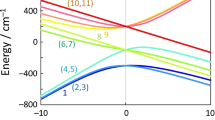Abstract
The complete ligand field, interelectronic repulsion, and spin-orbit interaction matrices were solved for the octahedral and tetrahedrald 4 andd 6 electron configurations. The results are employed in a detailed study of the crossover region. It is demonstrated that, close to the crossover, complicated mixing and interaction patterns may arise. A sharp crossover is encountered in the octahedrald 6 system exclusively whereΓ 1 andΓ 5 levels are involved. In all situations where the two ground levels transform according to the same irreducible representation, the crossover is redefined by that value of 10Dq where both ground terms participate in the lowest level to equal amounts.
Zusammenfassung
Die vollständigen Matrizen des Ligandenfeldes, der Elektronenwechselwirkung und der Spin-Bahn-Kopplung wurden für die Elektronenkonfigurationend 4 undd 6 in Feldern oktaedrischer und tetraedrischer Symmetrie diagonalisiert. Die Ergebnisse werden in einer eingehenden Untersuchung des “crossover”-Bereiches eingesetzt. Es wird gezeigt, daß komplizierte Mischungs- und Wechselwirkungsstrukturen in der Nähe des Überschneidungspunktes der Grundterme auftreten können. Ein scharfer Schnittpunkt wird allein im oktaedrischend 6-System erhalten, wobei die NiveausΓ 1 undΓ 2 unmittelbar beteiligt sind. In allen Fällen, in denen sich die zwei tiefsten Niveaus der zwei Grundterme nach derselben irreduziblen Darstellung transformieren, wird der Überschneidungspunkt durch denjenigen Wert von 10Dq neu definiert, bei dem beide Grundterme zum tiefsten Niveau zu gleichen Teilen beitragen.
Similar content being viewed by others
References
König,E., Kremer,S.: Theoret. chim. Acta (Berl.)23, 12 (1971).
— —: Theoret. chim. Acta (Berl.)22, 45 (1971).
Griffith,J.S.: The theory of transition metal ions. Cambridge: University Press 1961.
König,E., Kremer,S.: Ber. Bunsenges. (im Druck).
- - Unveröffentlichte Resultate.
— —: Theoret. chim. Acta (Berl.)20, 143 (1971).
—, Madeja,K.: Inorg. Chemistry6, 48 (1967); ibid.7, 2677 (1968).
Jesson,J.P., Weiher,J.F., Trofimenko,S.: J. chem. Physics48, 2058 (1968).
König,E., Ritter,G., Spiering,H., Kremer,S., Madeja,K., Rosenkranz,A.: J. chem. Physics56, 3139 (1972).
König,E., Ritter,G., Braunnecker,B., Madeja,K., Goodwin,H.A., Smith,F.E.: Ber. Bunsenges.76, 393 (1972).
Fisher,D.C., Drickamer,H.G.: J. chem. Physics54, 4825 (1971).
Bargeron,C.B., Drickamer,H.G.: J. chem. Physics55, 347 (1971).
Golding,R.M., Healy,P.C., White,A.H.: Trans. Faraday Soc.67, 1672 (1971).
Author information
Authors and Affiliations
Rights and permissions
About this article
Cite this article
König, E., Kremer, S. Detailed crossover studies of transition metal ions. Theoret. Chim. Acta 26, 311–320 (1972). https://doi.org/10.1007/BF01036244
Received:
Issue Date:
DOI: https://doi.org/10.1007/BF01036244




